There’s something spiritual about working with bees. You don’t expect it at first—you start with a course, some gear, a few frames—and before you know it, you’re watching life unfold through the wings of a tiny insect. A creature that produces, in its short life, just half a teaspoon of honey. And suddenly, nothing about honey feels ordinary.
Bee Personalities: From Charming to Fierce
Not all bees are the same—and just like people, they come with their own temperaments. The Italian honeybee is known for being gentle, calm, and highly productive—often considered the most charming and beginner-friendly of all. On the other hand, Africanized bees (often referred to as “African bees”) are more defensive and aggressive, making them challenging to manage, especially for new beekeepers. Choosing the right breed for your climate and comfort level is key to a positive beekeeping experience.
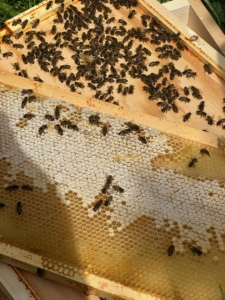
Learning to Bee Keep: From Books to Bees
My mom started her beekeeping journey in British Columbia, where the government offers an apiculture program. She took the theoretical course, but quickly realized: bees aren’t something you can just learn on paper. She needed to see, feel, and interact.
So she enrolled in a hands-on course at Campbell’s Honey Farm and took me with her to learn the process. That’s where things changed. That’s where I started forming my own approach.
Making Unconventional Choices
There are a lot of rules in beekeeping. Sugar water in the fall for the bees. Giving the bees antibiotics before winter. Treatments to ward off mites, viruses, and beetles.
But something in us hesitated. We didn’t want to medicate our bees. We didn’t want to feed them white sugar. It felt wrong—like giving fast food to a wild creature designed to harvest nectar from flowers. I trusted nature more than I trusted synthetic solutions.
People warned us. That we’d lose the hive. That my colony would fall prey to small hive beetles, Varroa mites, and other diseases. But guess what?
My bees survived. Not just survived—they flourished.
The hive doubled in size.
The bees were vibrant and healthy, and they made it through the winter on their own honey.
We had done the extraction end of August/ beginning of September. At the time, we only had one hive, and the extractions was the first, we ended up with 33 jars of honey.
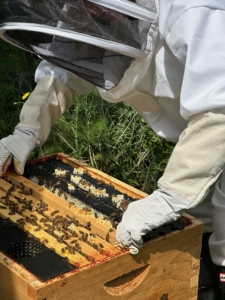
Why Bees Are Getting Sick
The decline in bee health isn’t random. It’s been happening for 10–20 years, and the cause is no secret: pesticides, herbicides, insecticides—chemicals sprayed on our food and flowers.
When an organism is constantly bombarded with toxins, it weakens. Like any living thing, bees become more susceptible to disease when their immune systems are compromised. So instead of fixing the root cause, the solution offered is medication—antibiotics, acids, antivirals.
That’s not a naturopathic approach. That’s not my approach.
How We Harvest Honey—Naturally
Honey extraction isn’t just technical—it’s intentional. First, you calculate how many full honey frames you have. A full frame means both sides are capped with wax. I chose to take less than half.
The process is simple:
- Set up your station.
- Gently cut the wax capping off the combs.
- Place the frames in the honey extractor and spin.
- The honey flows down, through a fine filter, and into your jars.
Some beekeepers jar immediately. Others let it sit for a few days to settle. Either way, every drop feels sacred. Knowing how little each bee contributes in her short life makes waste feel unthinkable.
The Inner World of the Hive
A hive is a masterpiece of organization.
- Nurse bees feed the babies.
- Housekeepers clean the hive.
- Foragers leave to collect nectar and pollen.
- Attendants care for the queen.
- Drones, the male bees, exist only to mate—and when winter approaches, the female worker bees push them out. Too many mouths to feed. No room for freeloaders.
And yes, 99.9% of the hive is female.
It’s a matriarchal universe that functions with near-perfect efficiency and zero regard for humans. They’re not here to please us—they’re here to survive, and they do so beautifully when left to their nature.
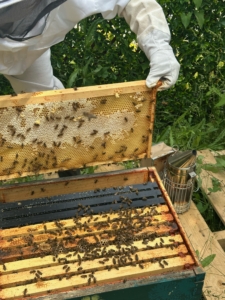
Tools, Tips, and Practical Advice
You don’t need much to start:
- A veil, gloves, and light-colored clothing (bees dislike dark colors).
- A smoker to calm them—it mimics forest fire scent, a cue for them to retreat inward.
- A hive tool & pliers – to move each frame (it does get sticky lol)
In warm months, I check my hive every 1–2 weeks. In the winter, I don’t open it at all. They huddle together around the queen, surviving on the honey left behind. They don’t hibernate—but they do slow down, reduce population, and live off what they stored.
Making the Most of the Hive
Bees don’t just make honey. They create:
- Beeswax—which you can melt down and pour into molds to make candles.
- Honeycomb—a delicacy and a structure for beauty products and skincare.
- Propolis—used in tinctures, salves, and natural remedies.
It’s all medicinal, all natural.
Honey: Nature’s Medicine
Raw honey is antibacterial, antifungal, and packed with nutrients. It can help treat:
- Burns and wounds
- Rashes and skin irritation
- Coughs and sore throats
- Dry skin
But here’s the catch: it must be raw. Once pasteurized or heated, honey loses its healing properties. Always go for unfiltered, unheated honey to retain the enzymes, pollen, and beneficial compounds.

Bee Wisdom
There’s something almost meditative about beekeeping. Being in their world—watching, learning, supporting—not only connects you with nature, but grounds you in your own body and breath. Even the way bees fly, how they know their queen by scent alone, how they circle and map their hive, is magic in motion.
Recommended Reading
If you’re just getting started—or even if you’re already hands-on and curious for more depth—I highly recommend:
Storey’s Guide to Keeping Honey Bees
by Malcolm T. Sanford and Richard E. Bonney
This guide covers both foundational theory and practical tools, offering everything from hive anatomy to seasonal care tips. Whether you’re looking to deepen your knowledge or gain the confidence to start, it’s a great resource to keep on hand.
Beekeeping is a decision. It’s choosing how much to take, how much to give, and how deeply you trust nature. For me, the answer is simple: support, don’t interfere. Respect, don’t control. And always leave the hive better than you found it.
Let the bees show you the way.
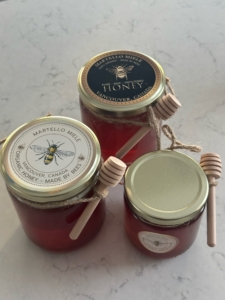
By : Sophia Iatrou & Anna Martello


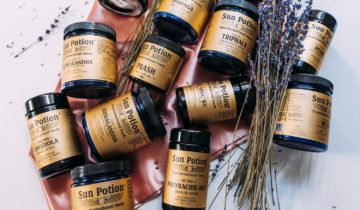


 No products in the cart.
No products in the cart.